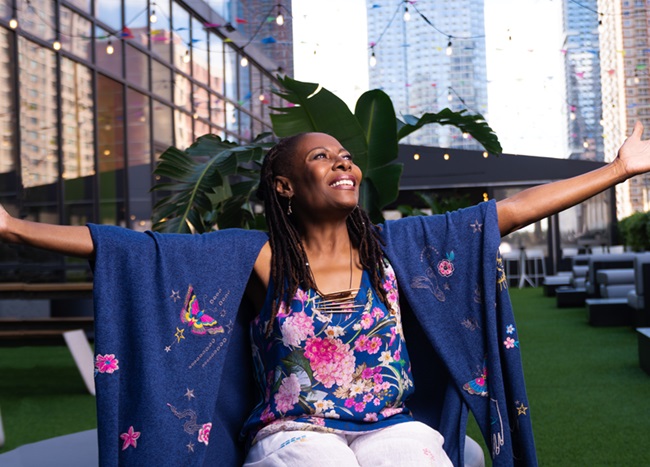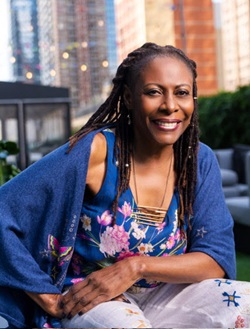
Publisher's Note: This is an exclusive interview with the iconic singer and songwriter Brenda Russell, created for SoulTracks by noted writer Jonathan Widran
(January 16, 2024) Though the incisive yet hopeful message of Brenda Russell’s new single “What Will It Take” seems tailor made for our time, the Grammy winning (and four time Grammy nominated) and two time Tony Award winning singer/songwriter originally wrote the song in the mid-90s, a few years after she hit the Billboard Hot 100’s Top Ten with her breakthrough trademark hit “Piano In the Dark,” which earned Grammy nominations for Song of the Year, and Best Pop Performance by a Duo or Group with Vocals. Her album Get Here was also nominated for Best Pop Vocal Performance, Female; in 1991, Oleta Adams’ 1991 recording of the title track “Get Here” was a massive global hit, reaching #5 in the U.S. and #4 in the UK. In 2005, Brenda co-wrote the songs for the Oprah Winfrey produced hit Broadway musical The Color Purple with the late Allee Willis and Stephen Bray. Its 2015 revival earned the singer her first Grammy for Best Musical Show Album.
Jonathan Widran: Your upcoming album is called Songpainter. Such a beautiful title. How did you come up with it and what does it mean to you? How does it reflect the music you will be presenting?
Brenda Russell: A fellow songwriter, Mary Unobsky, was listening to one of my songs one day and said, ‘You’re such a song painter, Brenda.’ I thought, now that’s a great title, thank you Mary! A few months ago. when I was getting the songs together for the album, the title hit me again like a lightbulb going off. It resonated because in addition to being a recording artist, I’m also a visual artist who creates charcoal portraits. I’m a painter of song and art. I’m a pretty artistic person all around and I like to tell stories in songs and pictures. One of the reasons I’ve never been a fan of music videos is that I would rather people create their own visuals in their minds than have a director create definitive images for a song that limit our perception.
JW: It’s been 20 years since your last album Between the Sun and the Moon. What prompted you to start writing and recording a new album?
 BR: I always wanted to record a new album. I was just busy doing other things, including being involved with The Color Purple in both decades and relocating to Austin, Texas. No matter what I’m doing though, I’m always writing music or trying to. My wonderful assistant Irina kept suggesting that I dig back into my old catalog for songs that I had never recorded. Turns out I had many that I still liked, including “What Will It Take.” I found the demo and I realized there’s a lot I could work with. The album has mostly new ones but that is one of the best from the vault. Returning to the studio is like riding a bike. All those creative juices come right back.
BR: I always wanted to record a new album. I was just busy doing other things, including being involved with The Color Purple in both decades and relocating to Austin, Texas. No matter what I’m doing though, I’m always writing music or trying to. My wonderful assistant Irina kept suggesting that I dig back into my old catalog for songs that I had never recorded. Turns out I had many that I still liked, including “What Will It Take.” I found the demo and I realized there’s a lot I could work with. The album has mostly new ones but that is one of the best from the vault. Returning to the studio is like riding a bike. All those creative juices come right back.
JW: What is your songwriting process?
BR: I’m lucky to have worked with record companies that allow me to do what I always wanted. I basically write what I feel about what is happening in that moment, without any preconceived rules. I wrote my first charted song ‘So Good So Right’ while washing dishes. That’s how inspiration hits, and I’m always writing something. I keep a book of title ideas and that helps a lot but there are no rules about how or when. It’s more like divine channeling, being something of a conduit. I wrote my first song as a teenager when I appeared in the musical Hair in Toronto. I cried because I was overwhelmed and had no idea what I was doing. I thought you had to go to music school to be a songwriter. It came naturally to me.
JW: Why didn’t you record and release “What Will It Take” when you wrote it in the 90s?
BR: Even with a few hits behind me, it was very discouraging to write something I believed in but receive no support from my then-publisher, who advised me against recording it. She didn’t think there was an audience for the song or its message. She was young, not a musician and didn’t have the imagination to hear its potential beyond the demo. It made me sad then, but I realize now that it wasn’t meant for that era but for our time now. I wrote it during the Gulf War when it felt like the world was in chaos, but the energy of the planet right now is in a place that could use a song like this. I see it as divine timing. I don’t think it’s a coincidence that I rediscovered the song at this specific time.
JW: Take me through the process from rediscovering it to recording and producing it? What made it the perfect lead single for the album?
BR: My co-producer Stephan Oberhoff is a musical genius and we work well together. I know he will bring out the best in anything I bring him. He understands me musically and immediately connected with what I wanted to do. As he explored the creative details of the song, he developed the vision of what it could be. When I heard his string arrangement, I started screaming in a good way. We also got the kids to participate in a serendipitous way. I think they’re the key to making the track work, because there’s a certain innocence in having people hear children ask the simple question, “What will it take to live right and be better?” Remember, it's their future we’re talking about.
JW: What do you hope the song’s ultimate impact will be?
BR: There was a key moment in the recording when I knew this could have multi-generational appeal. One of the singers, a 13-year old girl, was so moved that she cried. It meant so much that the song touched her. It made me feel that it could resonate with all kinds of people. I hope it inspires them to think kinder thoughts about each other – and open their minds a little bit.
JW: What’s your opinion of the new film The Color Purple which features the songs you wrote with Allee Willis and Stephen Bray?
BR: I attended the premiere and was blown away because it was so well done. The talent on that screen, the singing, the dancing, the acting, was overwhelming, The director Blitz Bazawule is a a brilliant guy. It’s the only movie I can remember with this kind of amazing, raw soul singing. The movie brings our songs to life beautifully. Years ago when we were writing the musical for the stage, Oprah wondered how we would make a musical out of Alice Walker’s book and Steven Spielberg’s original movie. And we did! Allee, Stephen and I were the right people to do it and we had such reverence for Alice Walker. People may have thought they weren’t ready to hear music in The Color Purple but it makes sense because music and church are how we got through everything, from slavery through Jim Crow and the civil rights era. We were thrilled to give Alice what she wanted.
JW: What is it about The Color Purple which made it a popular novel and film in the 80s and such an enduring part of our culture in the current century?
BR: What Alice wrote comes from the stories of her ancestors. She didn’t make it up. Her narrative is so real and human that no matter one’s color, they’re gonna relate to it because it’s about universal themes like love and forgiveness. Alice did what I have always aspired to do as a songwriter – write from the heart.
